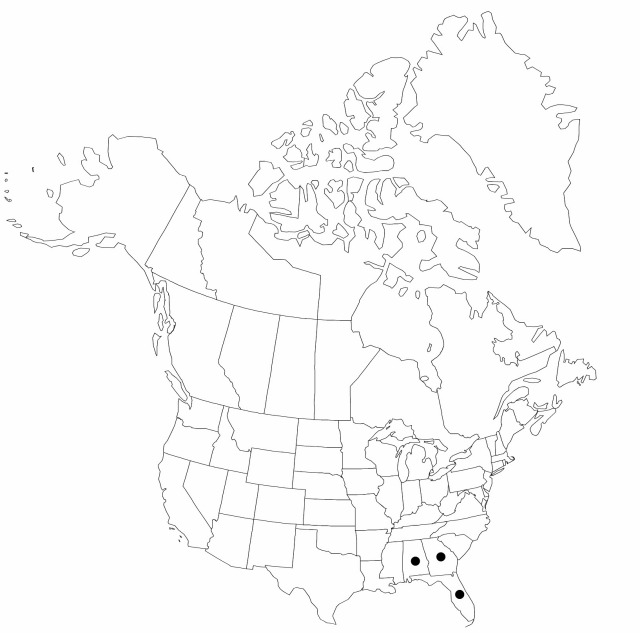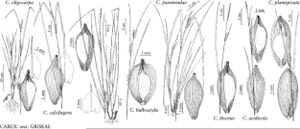Carex thornei
Novon 12: 516, fig. 4. 2002.
Plants densely cespitose; rhizome internodes 0.8–6.4 mm, 1.2–2.2 mm thick. Culms purple-red to 4.8–8.1 cm at base, 24–53 cm; vegetative shoots 28–49 cm, 0.5–1.3 times as tall as culms. Leaves green, widest blades 2.1–4 mm wide. Inflorescences 13–38 cm, 0.77–0.96 of culm height; internode between proximalmost scales in proximalmost spike 1.7–2.9 mm; internode between distal lateral spikes (1.6–)3.4–15.2 cm, longest internode between distal lateral spikes (5.3–)8.8–15.2 cm; longest peduncle per plant of terminal lateral spikes (2.2–)5.1–10.4 cm; proximal bract sheaths tight, hyaline band of sheath front with apex usually truncate or concave, occasionally convex, elongated to 2.2(–5) mm beyond apex; ligules 4–4.9(–9.6) mm; blades uniformly green, bract blade of distalmost lateral spike slightly exceeding or exceeded by terminal spike, longest bract blade of distalmost lateral spike 3.9–11 cm. Spikes 4–5, usually separate or the distal 2(–3) overlapping; lateral spikes pistillate, with 3–12 perigynia, longest per plant with 6–12, 5–21 × 3.2–4.1 mm, ratio of longest lateral spike (in mm) to flower number = 1.8–2.1; terminal spike 16–32 × 1.9–2.5 mm, longest per plant 17–36 mm, exceeding distalmost lateral spike. Pistillate scales 3–4.6 × 1.6–2 mm, body 1.6–2.6 mm, midrib prolonged as awn 1.1–2.5 mm. Staminate scales 4.3–5 × 1.4–1.8 mm, apex usually acute, occasionally obtuse, awnless. Perigynia distichously imbricate, prominently 53–64-veined, narrowly obovate or narrowly oblong in outline, 3.8–4.9 × 1.4–1.7 mm, (2.4–) 2.5–3.1 times as long as wide, 1.7–2 times as long as achene bodies, base gradually tapered, apex gradually tapered; beak absent or straight, 0–0.4 mm, 0–11% of perigynium length. Achenes 2.6–3.5 × 1.3–1.6 mm, tightly enveloped by perigynia, base abruptly contracted, apex abruptly contracted; stipe 0.2–0.6 mm; body 2.1–2.7 mm; beak straight, 0.1–0.4(–1.5) mm.
Phenology: Fruiting spring.
Habitat: Mesic deciduous forests, in sandy loams, usually on upper portions of flood plains and adjacent slopes
Elevation: 40–100 m
Distribution

Ala., Fla., Ga.
Discussion
Of conservation concern.
Carex thornei is endemic to the drainage of the lower Chattahoochee, lower Flint, and upper Apalachicola rivers. It frequently occurs with C. abscondita and C. basiantha.
Selected References
None.
